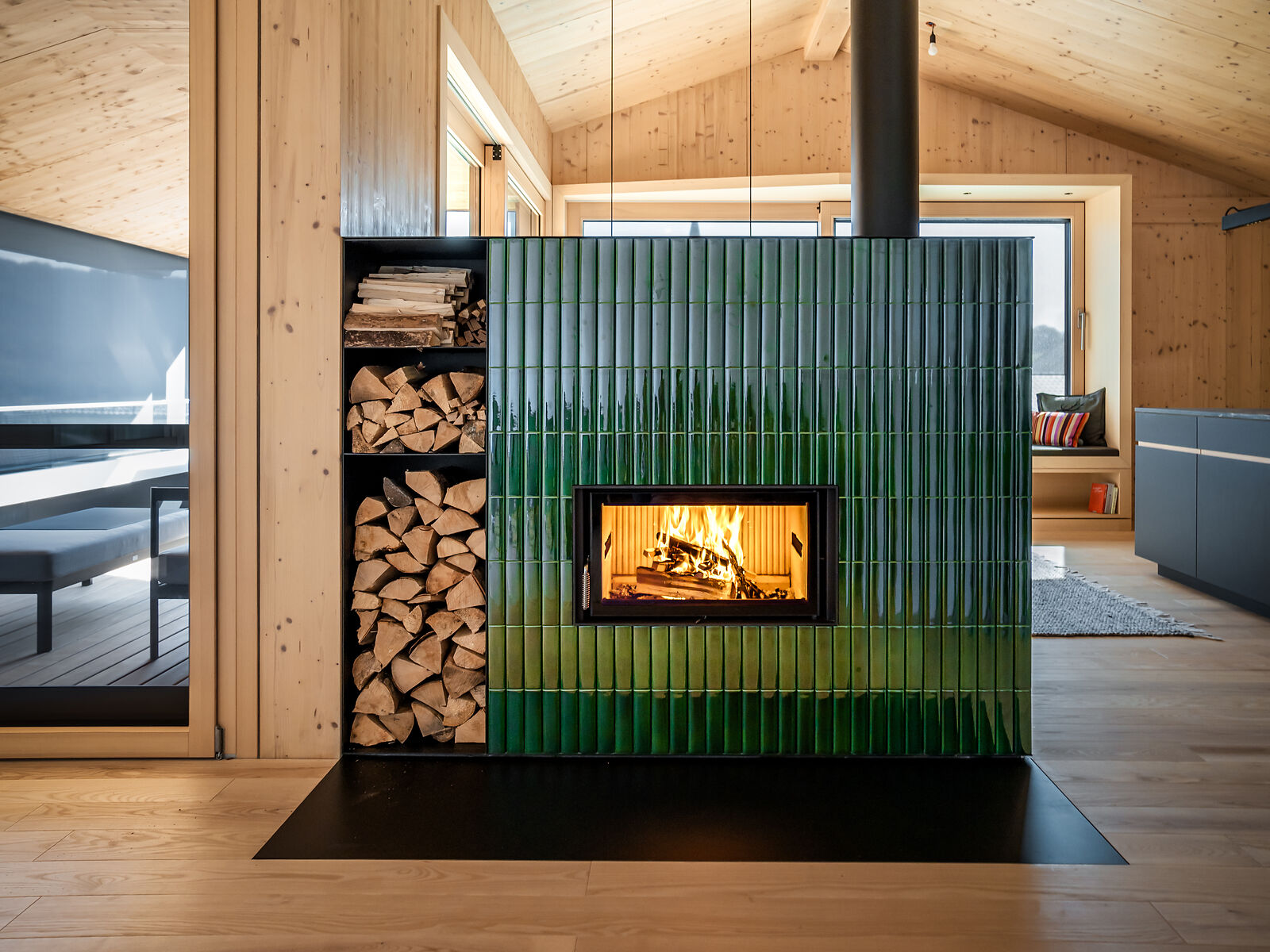Stoves and fireplaces
Tiled stove
WF 50 Flat
Product benefits:
- Pleasant and long-lasting radiant heat
- Durable insert made of high-quality cast iron
- Customisable heat storage options
- Custom design by skilled craftsmanship
- Generous view of the fire from one side
- Ideal for modern living spaces with clean, linear architecture
Main features:
Move your mouse over the icons to obtain more information about the individual main features.
Supplies the stove with combustion air from outside – ideal for modern, airtight buildings
Releases heat quickly and directly into the room as warm air
Automatically controls the combustion process for efficient and clean heating
Choice of mounting frame or door frame to match any interior style
Heat storage and heat release evenly over several hours
High-quality cast iron components for stability, durability, and premium value
Technical data
& Downloads

To device replacement
BRUNNER Tiled Stoves
Just like in grandma’s days, a tiled stove often still forms the heart of a home, a place where everyone enjoys gathering. The cozy warmth can be experienced especially well on the stove bench or in a built-in seating niche. In the past, it was designed to heat an entire house or several rooms, while the tiled stove’s cooktop was used for preparing meals. Thanks to its generously sized thermal mass, a tiled stove can absorb the heat generated during combustion and release it gradually over many hours. That is why, unlike a fireplace, a tiled stove is also referred to as a storage heater.

FAQ Tiled Stoves
- Tiled stove – when does it need to be replaced?
To prevent further increases in particulate matter and carbon monoxide, the German Federal Immission Control Ordinance (BImSchV) has set new limits. Fireplaces, heating fireplaces and tiled stoves must not exceed these values. Older appliances installed before 1985 had to be decommissioned already. Newer appliances installed between 1985 and 2010 must be retrofitted if they cannot meet the limits. Detailed information can be found in our magazine.
- How much does it cost to have a tiled stove cleaned?
By law, fireplaces must be regularly inspected, cleaned and serviced by the district chimney sweep. This usually takes place two to three times a year. During these visits, other components of the tiled stove can also be checked and, if necessary or requested, cleaned. A tiled stove cleaning takes about one hour, with average costs of around 100 euros.
- Who cleans the tiled stove?
Anyone who wants to enjoy their tiled stove for many years should have it professionally cleaned and serviced on a regular basis, ideally before the start of each heating season. Deposits form inside the stove as well as in the pipes and flue channels, and these must be removed. Soot deposits, for example, have an insulating effect that reduces heat output. They can also obstruct the flue gas path, which poses a safety risk.
Maintenance of a tiled stove also includes replacing wear parts such as seals. Cleaning and maintenance of tiled stoves are carried out by specialized stove builders. Cleaning and maintenance of the chimney itself is the responsibility of the chimney sweep.
- What must be considered when installing?
Before deciding to install a tiled stove, it is important to consider whether it fits your lifestyle. For people who are often away from home, a fireplace may be the better choice, as it produces heat quickly and releases it directly into the room. Anyone without sufficient space to store firewood should consider a gas fireplace instead. All these factors play a key role in satisfaction after purchasing a wood-burning insert. But no worries: our skilled trade partners across Germany and Europe provide comprehensive advice to help you find the right solution for your situation.
- What is the difference between a tiled stove and a fireplace?
While a fireplace is mainly about atmosphere and a great visual fire experience, a tiled stove is a true heating appliance. Its massive heat storage surfaces absorb warmth for hours and then release it slowly and comfortably over the same period. Of course, tiled stoves today also come with large glass fronts, both flat and corner formats. This makes them the perfect solution combining both worlds: atmosphere and long-lasting, healthy warmth.
- Painting a tiled stove – is that possible?
However, modern tiled stoves are now also built using other materials such as stone, plain plaster, metal or stainless steel. The important thing is that the materials meet the physical requirements of heat transfer. If you want to give your fireplace a new look, you can paint the tiled stove—but only with heat-resistant paint. Suitable options include radiator paints and any coatings that can withstand at least 120 degrees Celsius.
- Are there tiled stoves without tiles?
In the past, wood-burning stoves were almost always built with an outer shell made of tiles — which is why the name “tiled stove” is still used today. However, that’s no longer the rule.
Today, many different materials can be used to build a tiled stove, ranging from stainless steel to simple plaster. What matters most is that the materials meet the physical requirements for proper heat transfer.
Of course, a tiled stove can still be built with ceramic tiles, and there’s a wide variety to choose from — from traditional to modern, small to large, simple to elaborate.
- Tiled stove tiles – what are they made of?
Stove tiles are ceramic tiles made from fired clay, kaolin, fireclay, and water. They are heavy and have a high heat capacity, meaning they store heat energy long after the fire has gone out. The gentle, even radiant warmth they release allows you to keep the room temperature lower while still feeling comfortably warm — unlike warm-air stoves, which heat primarily through convection.
There are two types of stove tiles: simple tiles, also called vessel tiles, and composite tiles. Handcrafted ceramics are produced in several detailed steps, allowing for endless creative possibilities. A wide range of sizes, colors, designs, and surface textures can be tailored to suit any individual living style.
Ceramic surfaces are not only excellent heat retainers and visually appealing — they’re also especially easy to clean.
- What is the difference between radiant heat and convection heat?
Even though it may not seem like it, different wood-burning stoves produce different types of heat.
A storage stove generates radiant heat, which is transferred to the objects in the room through long-wave radiation. The surrounding air is not directly heated, so there is no air circulation — something generally considered healthier, especially for allergy sufferers.
Convection heat, on the other hand, relies on warming the air itself. Its advantage is that heat is released more quickly. In fireplaces or stoves with large glass fronts, for example, pleasant warmth is radiated directly into the living space even while the fire is burning.
- What is a tiled stove?
A tiled stove is a wood-burning unit that was originally designed to heat an entire house. Unlike a fireplace, a tiled stove is a storage stove. It stores the heat generated during wood combustion in its large, heavy structure and slowly releases it into the living space.
This happens through radiant heat, which warms physical objects — such as people — rather than the surrounding air. Although the name suggests that a tiled stove is covered with ceramic tiles, many modern tiled stoves are built using other materials such as plaster, stone, or metal.
Brunner Craftsmen search
Are you interested in a stove or heating system from BRUNNER? Please contact one of our craftsmen partners.

